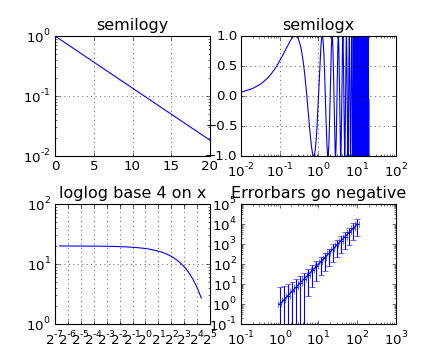

(Source code, png, hires.png, pdf)

import numpy as np
import matplotlib.pyplot as plt
plt.subplots_adjust(hspace=0.4)
t = np.arange(0.01, 20.0, 0.01)
# log y axis
plt.subplot(221)
plt.semilogy(t, np.exp(-t/5.0))
plt.title('semilogy')
plt.grid(True)
# log x axis
plt.subplot(222)
plt.semilogx(t, np.sin(2*np.pi*t))
plt.title('semilogx')
plt.grid(True)
# log x and y axis
plt.subplot(223)
plt.loglog(t, 20*np.exp(-t/10.0), basex=2)
plt.grid(True)
plt.title('loglog base 4 on x')
# with errorbars: clip non-positive values
ax = plt.subplot(224)
ax.set_xscale("log", nonposx='clip')
ax.set_yscale("log", nonposy='clip')
x = 10.0**np.linspace(0.0, 2.0, 20)
y = x**2.0
plt.errorbar(x, y, xerr=0.1*x, yerr=5.0+0.75*y)
ax.set_ylim(ymin=0.1)
ax.set_title('Errorbars go negative')
plt.show()
Keywords: python, matplotlib, pylab, example, codex (see Search examples)